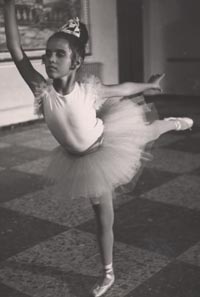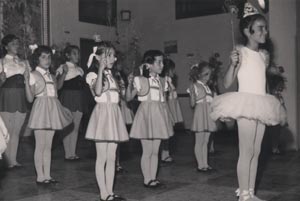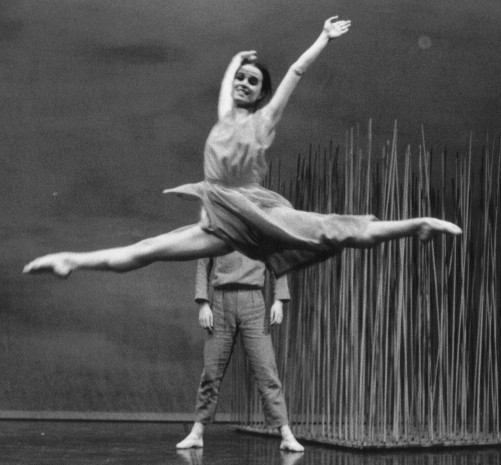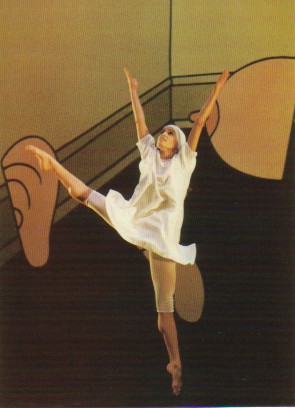CHILDHOOD
LEAVING
FOR TURIN
JUSA SABATINI
THE "CULLBERG BALLETT"
FAMILY
FUTURE PROJECTS
A TALE
TWO
QUESTIONS
CONCLUSION
AND GREETINGS
The summer in the “Salento during the evenings of august” offers a very suggestive sight, which can be appreciated with eyes and soul in the country, far from lights and noise of citiy. It’s enough to lift the eyes to the sky and plunge in to the deepnes of the universe full of stars. Peace! Trascendence!
Often
the sky brightens with a trail of light that breaks stillness of the
hemsphere. Meteors: comets like tears of Saint Laurence.
During one of these evenings of August (13/08/02) we met Pompea Santoro, a “comet” that every summer keeps on coming back since 1980, to light the sky of San Michele Salentino countries, in the south of Puglia. We love to call her this way, comet, even if it will be more appropriate to define her a “star” of the contemporary dance in the international scenery. This star was born in San Vito dei Normanni, but grew up in a little town nearby, San Michele Salentino, her father Michele´s family origins. We met her and her children Alma, 3 years old, and Alex, 1 year old, in her country – house in the district “Cutura”. She has a warm and firm look, quiet voice like the summer evening getting closer.
Her words are now dancing, the music, the suffused chirping of crickets, the rhythm of the rocking – chair in which she is sitting. Her words are chasing her memories of childhood spent here in San Michele: she thinks of her cousins with whom she played during the warm summer afternoons, when everybody else had a rest. In “De Gasperi” street in the grandmother’s kitchen garden, where they met to play song-competition and dance school.
She
says that the games children played in the past were very different, made
with what was found , like little stones (“li pitrud”)
high-heel shoes ,obtained with little tins of tomatoes etc.. Then she
thought of her aunt that made her peel almonds (“scurciuleje la menel”),
taste of broad bean with peppers or onion, and all other wild vegetables
which grow in our countries: “sckattapetr,
cicuredd e zangun”.
Pompea
was 6 years old when she left for Turin with her father Michele.
Afterwards they were joined
by her brother, 1 year old,
and her mother. The idea was to stay there until the operatation of her
brother’s hernia was over and then return to San Michele. But sometimes,
life, goes in
different directions.
Her father found a job where her uncles worked and soon they decided to stay in Turin. Pompea started the primary school and her mother took her also to a dancing school to realize her own dream and passion: her daughter as dancer.
Anita Carrino, the first dance–teacher that Pompea remembers with love, realised that the little girl had talent and adviced her mother to take her to a more serious dance school, and suggested the one directed by Jusa Sabatini. Despite the economical sacrifice she followed the advice.
JUSA
SABATINI
In 1971 Pompea was 9 years old when her father died in
a fatal accident at work. Everything changed in
Pompea’s family. Naturally, only for economical reasons,
Pompea’s mother decided to withdraw her from the dance- school,
but mr. Sabatini, took care of the situation, because he knew the
potential and the talent of the little girl. Afterwards the firm in which
her father worked (Calcestruzzi Torino), intervened to support the costs
of the school. Pompea continued her studies and dancing – mr. Sabatini
had a particular eye for her: he invited to the school high-quality
teachers such as Carola Zingarelli (Scala di Milano), Margarita Trayanova
(Opera of Sofia), Jean- Marie Dubrul (France) and others, to improve the
artistic and technical level of the students. They practised not only
classical dance, but also, jazz, spanish and russian dance. When she was
16 years old, mr. Sabatini took her to the “Tersicore” competition in
Brescia with a
variation of Alonso’s “Carmen” tougth by Mss. Trayanova. She tells
us that she felt appreciated by the audience and after the first three
winners were named she was very surprised not to be among them.But the
jury assigned her a special prize “for particular artistical talent”.
Very soon this price brought her to take part of another big event, even a
historical one; the first “Two worlds festival of Spoleto”. Alberto
Testa, that was one of the members of the jury in the “Tersicore
contest” , wanted her in the Spoleto festival, since a dancer cancelled
due to health problems. Dancing with some of the Teatro alla Scala dancers,
she had success again. After the perfomance she received a proposal from
Pippo Carbone, who was in the audience, to join the Cullberg Ballet of Stockholm (Sweden);
a proposal that left Pompea with some doubts, because at that time she
didn’t know anything about the swedish ballet company and she had just
passed the selection to attend the dance school of the Teatro alla Scala
of Milano. Maestro Sabatini and her mother
wanted her to attend this school, but she decided otherwise.
|
|
In 1978 she was 16
and decided to go to Sweden and join the Cullberg Ballett, only for a year
of work. Pompea, for the first time, experienced a different style of
dancing, the unknown contemporary dance. Trying to explain the difference
between classical and modern dancing she says that the first one is based
on fixed rules, just like reading and playing music, but with different
methods, you need very good technical skills to be able to enjoy it.
On the other hand modern dance is free from rules, even if a
good classical tecnique is still fundamental. You have a different
artistic freedom and every choreographer may discover a new style and way
of moving . She really liked the style of Mats Ek, son of Birgit Cullberg-
creator of the Cullberg Ballet of Stockholm. She
worked with Mats Ek for 24 years, and had the possibility of
working with very important choreographers like Jiri Kylian, Ohad Naharin,
Carolyn Carlsson and Nacho Duato, and dancing on the world ´s most
important stages. The company came to Italy almost every year, but in 1980
the choreographer Sebastiano Coppa invited her to the Teatro alla Scala of
Milan for the festival “Nervi, my dear” where she danced for the first
time as guest. The second time was in
1989 in Positano, where she got the “Positano danza” award
given to her by Alberto Testa, the man that discovered her.
During the
years she danced and knew nearly all the choreographies of Mats, who was
getting more and more important in the dance world and very demanded in
different theaters. So, Pompea accepted to collaborate with the
preparation and teaching of his ballets
across Europe; work that kept her busy for 5/6 years during her
summer vacation and her free time. The first teaching job was in Munich in
1996 where she staged “Giselle”.
She is more satisfied teaching
the choreographies of Mats Ek than to dance herself. In 1997 the double duty of teaching and
dancing was successfull
in the Scala of Milan. Elisabetta Terabust invited her to stage,
and dance “Giselle” of Mats with Massimo Murru. Pompea says that it
was a wonderful experience, also because she had the possibility, for the
first time, to dance with live music performed by the orchestra of Scala.
Nowadays she traines every morning accompanied by her brother Cosimo,
teacher of music in the Teatro Nuovo Torino.
She has also staged “Giselle” at the Paris Opera and at the
Gothenbourg Opera in Sweden.
|
Giselle
:
Coreografia Mats Ek, scena del secondo atto. |
After dancing at la Scala in 1997 Pompea
felt that she had reached an important goal in her carreer, so she decided
to stop for a period with the thought and big wish to have a child. She fell in love in 1986 with Veli
Pekka Peltokallio (dancer in Cullberg Ballet) and their love story lasted
many years. When they decided to have a child, she wanted to marry as a real southern italian women, for
Veli who was used to another culture it was not very important : he
is the perfect husband and they have been happy together, so far. They
married in june 1998 with a
civil cerimony at 9.00 a.m. One hour later they went to the theatre to
work and informed
all their friends and collegues who celebrated the married couple.
The party carried on in Finland with Veli’s relatives and in San Michele
Salentino in “Cutura” with Pompea’s relatives. In 1999 Alma was born.
Pompea didn’t feel a strong need to dance and decided to teach Mats’s
choreographies with bigger
and bigger satisfaction and amusement, a job that brought her around the
world, in these years, with little Alma. In 2001 Alex was born and Pompea
found back her original fit, which stimulated her to dance again.
FUTURE
PROJECTS
The most important project, in which Pompea was engaged since started,
when the opening of Auditorium of Lingotto in Turin in 1994. Pompea
perfomed “Carmen” this
time Mats’s version (with the Cullberg Ballet) to an audience of about 2000 people. During that occasion
Pompea met Gian Mesturino, Director of Teatro Nuovo in Turin, who proposed
her a professional and artistical cooperation. The first proposal was
dancing in his company but Pompea refused. Instead she accepted the role
of “artistic advisor” of the company. She started with very ambitious
projects, but it become more and more difficult for many different reasons.
Today things are changed, Pompea
has returned to Turin, since she has
retired from the Cullberg Ballet (artists in Sweden enjoy this
privilege after 20 years of artistical activity), where her family now
lives and where she dances and collaborates in the
artistic direction of the company of Teatro Nuovo.
At the same time she will continue the cooperation with Mats Ek as his assistant. In March 2002 she was engaged in London at the Coven Garden to stage “Carmen” with Sylvie Guillem (one of the greatest dancers of our time). There are other projects, that Pompea prefers not to speak about. She assures us that she will inform us when these projects will be concrete, so that we can inform the public through our web site, in which we hope to talk also about her two children Alma and Alex.
Pompea tells us stories from her career. In particular, she
remembers with pleasure the meeting with the big russian dancer Rudolf
Nureyev, in the beginning of
’80, when he was invited to dance with the Cullberg Ballet in a
production of “Miss Julie” of Birgit Cullberg .Pompea had a small role
, but she danced with Rudolf Nureyev for some minutes.
When this production finished, Pompea and the russian dancer
were in the same plane to Paris: Pompea in economy class, and Nureyev in
first class naturally. With surprise, the young Pompea was invited by
Nureyev for a glas of champagne by his side. She remembers that it was
very amusing and at the same time she was honoured by that welcome: after
all Pompea was a nobody, but
a very important friendship had started
in only 3 weeks time! She says “a
very extraordinary person that has left in me some unforgettable
things”.
Me
and my friend Pino Calò, who had organized this meeting with Pompea,
proposed two questions to finish this interesting and exciting talk.
What
do people express with dance? And in particular, what does Pompea express?
“It
is not an easy and clear matter!
I think this is one of the reasons for being what I am , at least
people say so! Then who watches me judges if i am a
true artist and have the so called “charisma”. When a true
artist gets on the stage, he lightens and he transmits all kinds of
feelings. The Art of dance is not appreciated by all, so it is essential
that also people who are not specialist are reached. It’s
something that can not be tought, but I believe one can help a young
dancer to understand how to get in touch with his or her own feelins, by
giving them the right opportunies. I had the fortune to have a natural
talent and physical abilities, but the most important has been that I have
had very significant people around me like Mats himself and Lena Wennegren
that have followed me during the years helping
me to become what I am today.
Then there are different methods to approach a role. There is the
artist that
reads and studies carefully a certain character or situation. I
follow my instinct, I listen to the music and I watch carefully my
choreographer trying to understand what he is looking for. I think that
following too much your intellect ,you limit your instinct and spontaneity.
I have always trusted my heart.
Another
thing that I have learned and that I try to teach
young dancers is
to use
their mind to mesure the energy while composing the movement,
and to dance with the heart, in other words,
to be able to find freedom within control and presicion”.
But
Pompea, who is she? And what is the role she liked to interpret?
“All
the roles i have danced and dance today have a bit of me. In contemporary
dance it is easier to find roles and characters that are real . This is
also one big difference between classical -and contemporary dance: in
classical dance characters and situations are normally unreal, in
contemporary dance situations and characters are often real, the
choreographer gets inspired by his own experience or every day
life.
An
example can be “ Giselle” of Mats Ek: in the
original version (classical) Giselle dies of a heart – break for
a not returned love and becomes a ghost; in Mats’s version
(contemporary) the protagonist becomes mad and instead,
goes to a mental hospital.
This
version is real,it
happens to many women to be abandoned and left with many problems.
This
ballet has become famous all over the world. I have danced it
many many times, swapping this role with Mats’ wife, Ana Laguna,
a dancer that has tougth me a lot and I have learned
just by watching her.
Another
example can be the contemporary version of “Sleeping beauty”, where
Aurora`s, the protagonist`s sleep is due to using
drugs".
It’s
late. Alma and Alex have fallen asleep near their mother Pompea, the three
of them on the swing which slowly stops it`s rhythm. Amazed to see so much
tenderness and love, we realise that the role of mother is her best.
Pompea agrees with us. We leave, but we are able to make her say a
greeting in dialect of our town
which we send to all of you that read these pages: “staten
bbuen”.
-------------------------------------------
e-mail: pompea.santoro@tin.it

Pompea Santoro - 1970

Gli eventi più importanti della sua carriera artistica: |
|
| 1978 |
Concorso
“Tersicore” di Brescia; |
| 1980 | Festival “Nervi mia cara”; |
| 1989 | Premio “Positano Danza”; |
| 1990 | Galà a Fiesole: Italiani all’estero; |
| 1993 | Premio “Karina Ari Hedersstipendium” in Svezia; |
| 1994 |
Premio
“Vignale Danza” e “Danza Danza”; |
| 1995 | Inaugurazione del “Vignaledanza”; |
| 1997 | Scala di Milano. |



